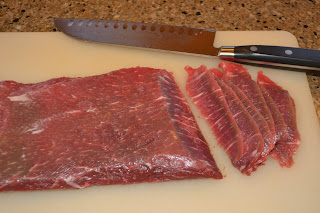New Year's Eve Fondue.
Parmesan Cream Cheese Fondue
1 Tbsp.butter
1 clove garlic, minced
1 1/2 cups milk
2 - 8 ounce bricks cream cheese, softened
1/2 cups grated, dry, parmesan (not fresh)
Melt the butter in the fondue pot. Add the garlic and cook for 1 minute. Add the milk, cream cheese, and parmesan and stir together. Cook on low to medium heat until slightly bubbly and warm. Turn to low. We like to dip french bread cubes into this fondue.
Cheddar Cheese Fondue
1/2 cup chicken broth
1 tsp. garlic, minced
2 cups extra sharp cheddar cheese, grated
1/2 tsp. pepper
1/4 tsp. ground mustard (powder)
1 tsp. Worcestershire sauce
Pour the chicken broth into the fondue pot on medium heat. Add the mustard powder and pepper and whisk them together. Add the garlic. Stir it in. Add the cheddar into the mix in small amounts. Continue to stir until well blended. Fold in the Worcestershire sauce. Turn to low. This fondue is for lightly steamed broccoli and cauliflower dipping.
Hot Oil
chicken breast, cubed
pork, cubed
steak, cubed
shrimp
mushrooms
cream cheese wontons
Mozzarella cubes
Vegetable oil
To prepare the meats I like to freeze them for about 2 hours before cutting them. The frozen meat is easier to cut in to uniform cubes.
Heat the oil on high in the fondue pots. Each of the meats takes different amounts of time for cooking. The shrimp cooks the fastest, followed by the steak. The chicken and pork need the longest in the oil. Do not eat under cooked chicken or pork.
The mushrooms are easy and quick cooking. The cream cheese wontons are easy to put together. Put a little bit of cream cheese in a wonton wrapper and fold the corners up, pinching them in the middle. For the Mozzarella cubes, cut the Mozzarella into cubes. In a small bowl beat 2-3 eggs. In another bowl add Italian bread crumbs. Dip each cheese cube into the egg and them into the bread crumbs and then repeat for a second coating.
The sauces. For the meats we like to dip the cooked chicken and pork in Peanut Sauce, or bbq sauce. The shrimp is really good with cocktail sauce or drawn garlic butter. The steak we like to also dip in the butter or just sprinkle with garlic salt. For the Mozzarella cubes we use a simple jar of marinara sauce. The wontons we dip in a homemade Sweet and Sour Sauce.
Sweet and Sour Sauce
1/2 cup pineapple juice
1/2 cup sugar
1/2 tsp. salt
1 tsp. cornstarch
2 Tbsp. oil
1/4 cup ketchup
In a small bowl combine the pineapple juice, sugar, salt,and cornstarch. Set aside. In a small saucepan add the oil and ketchup. Stir together and heat over high heat until bubbly. Add the pineapple juice mixture and stir together over high heat until the sauce thickens. Remove from heat. It will continue to thicken slightly as it cools.
Peanut Sauce
1/4 cup creamy peanut butter
2 tsp. soy sauce
1 Tbsp. brown sugar
1 Tbsp. lime juice
1/4 cup coconut milk
1/4 cup water
1 clove crushed garlic
1 pinch of red pepper flakes (to taste)
Mix all the ingredients together and heat over medium high heat until thickened.
8 - 1.55 ounce Hershey's milk chocolate bars, broken into squares
1/4 cup milk
10 large marshmallows
1/4 - 1/2 cup heavy cream
Place the broken chocolate bars and milk into the fondue pot on medium heat. Stirring constantly add the marshmallows until melted. Gradually add the heavy cream until desired consistency. ( I like it a little on the thinner side.)
We like to dip bananas, strawberries, brownie bites, rice krispie squares, angel food cake cubes, and mini cream puffs in the chocolate fondue.
Caramel Fondue
40 unwrapped caramels
1/2 block cream cheese, softened
3-5 Tbsp. milk
Combine the caramels, cream cheese, and 3 Tbsp. of the milk in a fondue pot. Cook over low heat, stirring constantly until melted. Add the other 2 Tbsp. of milk if desired for the consistency.
Apples are the favorite for the caramel fondue.




















































